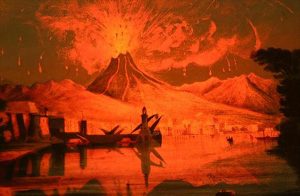
Just over 200 million years ago, long before the demise of the dinosaurs, a cataclysm killed off a significant chunk of the planet’s animal life. The leading theory implicates massive volcanic eruptions, triggered when the supercontinent of Pangea was ripped apart into separate continents.
A new study co-authored by USC Dornsife researchers strengthens evidence for that theory and has wider implications for how rapid climate change can affect life on Earth. Along with lava flows, the volcanic eruptions released massive amounts of the greenhouse gas carbon dioxide, creating havoc in the ecosystem.
The study, published April 6 in Nature Communications, charts the sharp escalation of the element mercury in samples of rock preserved from the Triassic-Jurassic extinction event. It isn’t the ordinary mercury you’d find on the surface of the planet: Isotopic data suggests it can be traced to the eruptions.
Frank Corsetti, professor of earth sciences, was a co-author on the study along with: David Bottjer, professor of earth sciences, biological sciences and environmental studies; Josh West, Wilford and Daris Zinsmeyer Early Career Chair in Marine Studies and associate professor of earth sciences and environmental studies; and William Berelson, professor of earth sciences and environmental studies and chair of earth sciences. Graduate student Joyce Yager and a host of current and past graduate students, including Kathleen Ritterbush, now an assistant professor at the University of Utah, and Yadira Ibarra, now a postdoctoral research fellow at Stanford University, were also authors.
Mercury rising
Corsetti said the rise in mercury seems to match changes in the planet’s biosphere during the era. As the mercury was found to rise in the rock samples, it matched a wave of animal extinctions on the planet’s surface and in its seas. The mass extinction peaks just as the level of mercury does; biodiversity begins to return once the mercury level recedes, about 700,000 years after the event began.
The mercury, Corsetti said, serves as a kind of fingerprint for a massive volcanic eruption in what’s known as the Central Atlantic Magmatic Province (CAMP). Essentially, CAMP was the spot in Pangea where the Atlantic Ocean would later appear after the land mass split.
CAMP’s appearance was a cataclysm on its own.
“If that much material erupted today, it would cover the contiguous United States with about 400 meters of lava—it was an enormous series of eruptions,” Corsetti said.
But the reason CAMP is suspected of being the culprit in the mass extinction has to do with carbon dioxide—the gas that climate change experts now worry is being released into the atmosphere in rapid and massive quantities.
“By some estimates, it rose nearly as rapidly as we’re putting CO2 into the atmosphere today,” Corsetti said. “We wanted to see how the Earth system responded from a rapid rise of CO2. The spoiler alert is that there was a mass extinction. What we’ve been able to do is use this mercury as a fingerprint to tie the event to the volcanos, and therefore the emissions.”
The Triassic-Jurassic extinction is particularly pertinent because it was selective, Corsetti said. It preferentially affected coral reefs and animals most similar to the ones common in today’s oceans. An earlier and more severe event, the Permian extinction—sometimes called “the mother of all extinctions”—was even bigger, but the dominant organisms affected were different from the ones common today.
That makes the Triassic-Jurassic event perhaps the most relevant mass extinction to study when trying to predict what might happen with rising CO2 levels, Corsetti said.
Reference:
Alyson M. Thibodeau et al. Mercury anomalies and the timing of biotic recovery following the end-Triassic mass extinction, Nature Communications (2016). DOI: 10.1038/ncomms11147
Note: The above post is reprinted from materials provided by University of Southern California.









